|
THE
PICKERING FAMILY
LIFE IN SHERWOOD
FOREST, CLARK CO., WISCONSIN
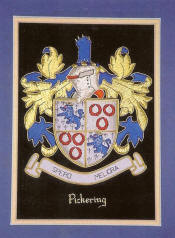
Excerpt from
Lloyd D.
Pickering's Family History (pg. 28 - 58)
(This is a copyrighted work and the following is presented with the
author's permission, given prior to death)
Part [1]
[2] [3]
[4]
|
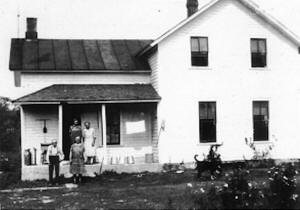
St. Germain Home
Sherwood Twp., Clark Co., Wisconsin
|
Hannah Pickering’s father, James F. Sparks, lived
at Nevins before Byron moved there from Plainfield. James was the
only one of the grandparents that the children knew. James’
wife had passed away and he lived with his daughter, Elizabeth
(Mrs. David St. Germain), most
of the time. It was the custom for the elder members of the
family, who were alone, to live at the homes of the younger members of
the family. When James felt that he had stayed long enough with
any one of the families, he would return to Elizabeth’s
home. She and her husband were kindly generous people, very much
given to hospitality either within or without the family
circle.
Grandpa James usually carried a musket about six feet
long wherever he went. He used a lot of powder and killed just
about everything he shot at. There was a big buck around Nevins
that the community called “Old Golden”. Though the
families relied on
|
wild
game for much of their meat, “Old Golden” enjoyed a degree of
immunity. The buck was also very wary and intelligent. He finally
disappeared, but he was never shot by James or any of his
people.
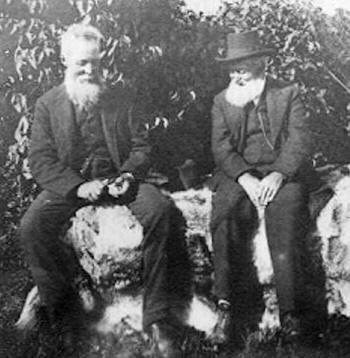
Byron Pickering
& James Sparks
Dave
remembered one occasion when his Grandfather James brought with him a box of
fishhooks. He gave Dave three of them. Dave was elated.
Eventually he sold two of the hooks, as one was sufficient for him.
It was such a small gift, but it brought great happiness to a young
lad.
Byron
began logging operations on his homestead as soon as he arrived. This was
his livelihood, together with some seasonable outside work. At one time
the Township of Sherwood had been completely forested in white pine. As
the logging companies moved on, the areas left were made available for sale to
the settlers. This is how Byron was presented with the opportunity to
purchase a place called “The Ranch” from T. J. LaFlesh. It has been operation headquarters for the
lumber company and not only had cleared land, but numerous other
buildings. There was also a large two-storied house. Byron bought
“The Ranch” for $1,000.00. This was sometime in 1886.
The house was on Section 3 in Sherwood Forest. He borrowed the money to
pay for it from Mr. Dangers, a businessman at Neillsville. Myron referred
to this house in his memoirs: “When I was 13, my Dad bought buildings and
farm land that had belonged to a logging firm and was sold at auction for one
thousand dollars. Our home became the stopping place for friends passing
by. There was a long table in our kitchen that would seat a dozen or more
people and it wasn’t uncommon to have the table full. One of the
features of my Mother’s table was strawberry shortcake, two layers,
covered nicely with butter and topped with berries. ”Life improved
immensely for Byron’s family when they moved to The Ranch. There
were fields for crops and pastureland for a small herd of dairy cattle.
They also acquired a few sheep for mutton and wool and hogs for the family
meat. Hannah also had a large flock of chickens.
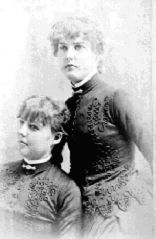
Helen & Edith
Pickering
Byron contracted for a logging camp in Sherwood Forest during the
winter of 1886-87. The operator was paid on the basis of board feet cut
and delivered to the mill site. He had to keep a close check and fight
for every penny because the mill owners would swindle you if they could.
The lumber obtained was sold to the settlers, transported to nearby towns, or
to the rail head about seven miles away where it was shipped. His
daughter, Edith, cooked for the camp and Byron gave her a $20.00 gold piece at
the end of the season.

Sherwood Township
Town Hall
Byron occasionally contracted for the construction of the buildings
in the community. Sherwood Forest Town Meeting Highlights: June 24,
1891. “The town board decided to let the building of the town hall
to Byron Pickering in conformity to specifications thereof for the sum of
$525.00.” The building was finished and inspected on December 15,
1891. The frame and woodwork were of oak. The town hall is still
standing (2013) and serves as a community center for the area. It was
used as a church for a long time and Byron taught Sunday school here for
years.
Byron continued to farm during the summer and made firewood and
logged during the winter. There was good quality hardwood on the forested
portion of the farm and this could be taken to the mill. Byron also
supplemented his livelihood with millwork. Hannah lived in dread that Mr.
Dangers would foreclose on their mortgage and they would lose The Ranch.
She churned butter and sold eggs to help pay off the debt. Dave told of
the time that he needed a coat badly. His mother kept after Byron until
he sold one of the sheep and bought a coat for Dave.
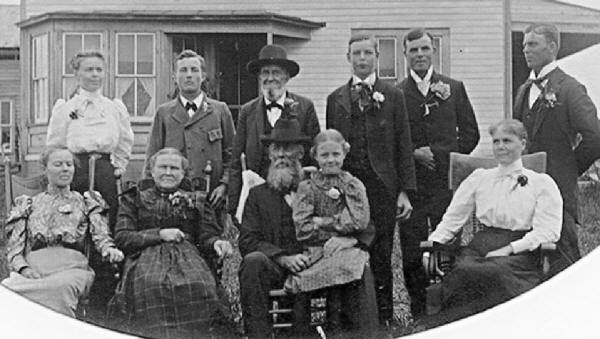
The Byron Pickering Family at their "Ranch"
In
1894, Byron did a considerable of amount of work on the house. He covered
it with siding and added an impressive cupola at the top. Edith’s
son, Ward, wrote about his grandparent’s home: “There were five
large rooms downstairs and seven or eight bedrooms upstairs and a full basement
with a hot air furnace. The house was well finished inside and even
boasted a bathroom. Though there was no running water, there were washing
facilities and it was always comfortably warm in the winter. Ona used the
cupola as a place to weave rugs on her loom. The windows on all four
sides looked out over the countryside. It was the most modern farmhouse in the
vicinity. Their home was the ‘haven’ for many traveling horse
and buggy salesmen in those days. No one was ever turned away. The
teacher for the nearby district school stayed there and four of them became
daughters-in-law. The ministers who came at stated intervals were welcome
and at times, when there were revival meetings, they stayed several days with
free lodging for themselves and their horses.”
How
satisfying it was to leave the house in the morning and look upon the
acquisitions that had come with The Ranch. To the south was the
road. To the west was the creek. To the north and east were broad
fields. Several barns bordered the lawn to the east and there was plenty
of room for the livestock.
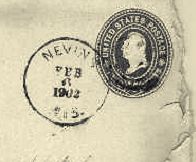
1902 Nevin's Wis.
Post Mark
Byron
was postmaster of the Nevins Post
Office, which served Sherwood Township. There was a room built on the
corner of the house for the Post Office. Mail was transported tri-weekly
from Neillsville. The “stage,” as it was called, consisted in
summer of a single-seat light wagon and in winter a similar type sleigh, drawn
by a very nice team of horses. Joe Janes was the driver for many
years. The next day, Ona delivered the mail that was left for the
Dewhurst Post Office, which was about four miles south.
When
Dave was about nine years old, he and a neighbor
boy put a rope around the necks of two of his Dad’s pigs. When the
pigs felt the rope tighten, they tried to escape, pulling harder and
harder. Dave wasn’t expecting that kind of a response. He was
afraid his mother would hear the pigs squealing, so he ran to take the rope off
one of them and caught his finger under the knot just as the pig took off
again. The finger was so badly mutilated that it left a lifelong
scar. There was no doctor to give it proper care and his mother,
appreciating the escapades of her large family, was simply thankful that Dave
didn’t lose his finger.
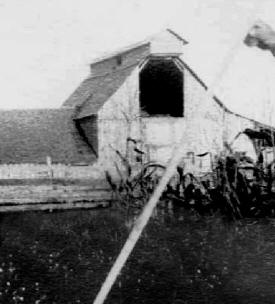
Byron Pickering's
Barn
One
spring morning, Dave and Myron were sitting on the back steps when they heard
agonizing calls for help coming from the big barn. They jumped up and rushed to
the rescue as the cries of “Help me! Help me!” continued to come
from the inner recesses of the barn. They were frightened at what they
might find, expecting some tragedy. The boys peeked around the barn door
and there in the middle of the drive through was Earl, who was little more than
ten years old. He had each hand clasped firmly around the ram’s
horns. The ram had all four feet dug firmly against the floor. With his
head down, he was holding Earl at bay so that he could not move out of the way
without being trampled. Dave and Myron shouted loudly in unison,
“Let go, Earl! Let go!” Earl responded, “I can’t
let go!” He was afraid the ram would back up and belt him a good
one. By now the older boys had reached the struggling pair and they
jumped one on either side of the ram and grasped a horn. Then they told
Earl to jump. Breathless by now, Earl jumped to the side and the ram
bounded out the door with a bleat. Dave and Myron sat down to
laugh. Earl, nursing his chagrin, didn’t really think it was any
laughing matter.
Jessie, the youngest of the children, was born on April 7, 1889, at
Nevins. Ona was still at home and she did the housework. Hannah had
become somewhat frail, but she baked the bread. Their home became an
oasis for all who passed through the community, whether they were evangelists,
politicians or vendors. Church services
were sometimes held in the large living room.
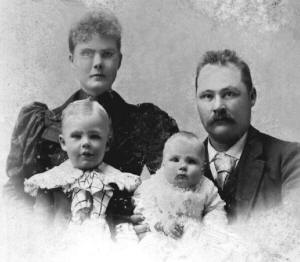
Edith, Marcus, Ward
& Blanche Wilson
The
house was gaily decorated on March 5, 1890, because the oldest daughter, Edith,
was going to be married. She had chosen Marcus Wilson as her
husband-to-be. He was born in Plainfield in 1865 and now owned a very
nice farm near Granton. The couple went to live there for a short while
before Marcus’ job as engineer on the railroad took him and the family to
Ashland, where their first son, Ward, was born May 4, 1891. Blanche was
born in the home of her grandparents at Nevins on July 4, 1893. Irene was
born in Ashland on November 26, 1895, and James Byron in Chippewa Falls,
Wisconsin, on November 28, 1898.
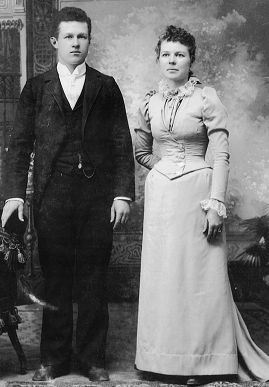
Cy & Helen
Stockwell
Helen
was teaching school in her home district when she met and married Cyrus
Stockwell on June 18, 1892. He started to work for the Chicago and
Northwest Railway as a young man and he was now the station agent at Granton,
so that is where they lived. Little George was born to them on June 29,
1896, and Bernice was born on November 20,
1898.
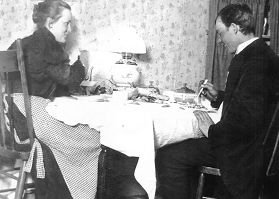
Myron & Bessie
(Borgers) Pickering
During
the years at The Ranch, the boys became young men. Slowly, they absorbed
the work and shared the responsibilities of the farm. Myron married
Elizabeth Jane Borgers on April 27, 1897 at her parents’ home in
Neillsville. She had taught school at Nevins. After marrying, they lived
on Edith and Marcus’ farm. Myron did very little farming and lived
there more for custodial purposes until it could be sold. The farm was
just outside Granton and he worked in the village.
Besides serving as postmaster, Byron was clerk of the town of
Sherwood, Clark County. He was also interested in politics and later on
he edited a community paper and sent out circulars to inform everyone about
civic affairs. These were happy and productive years.
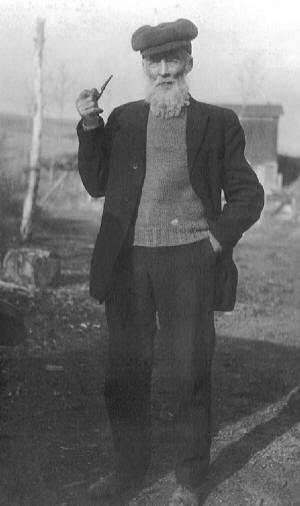
Byron
Pickering
Byron was a large man, tall with broad shoulders. He was very
powerful in strength, without an extra ounce of weight. His eyes were
blue and direct. He had a beard and no sign of baldness. Hannah was
a small chubby woman with a pleasant countenance. She was the essence of
patience and gentleness. For these two patriarchs life was full and
rewarding with their family around them. The gentleness and kindness
Hannah and Byron displayed at home was passed on to their children. Each
of them grew up with Godliness as a part of their standard of life. They
forged out their lives with the same generosity that was part of the life of
their parents

The Family in Front of
the Ranch House
Back row: Ona, Earl, James
Sparks, Allie, David, Myron
Front row: Helen, Hannah,
Byron, Jessie, Edith
Continue
|